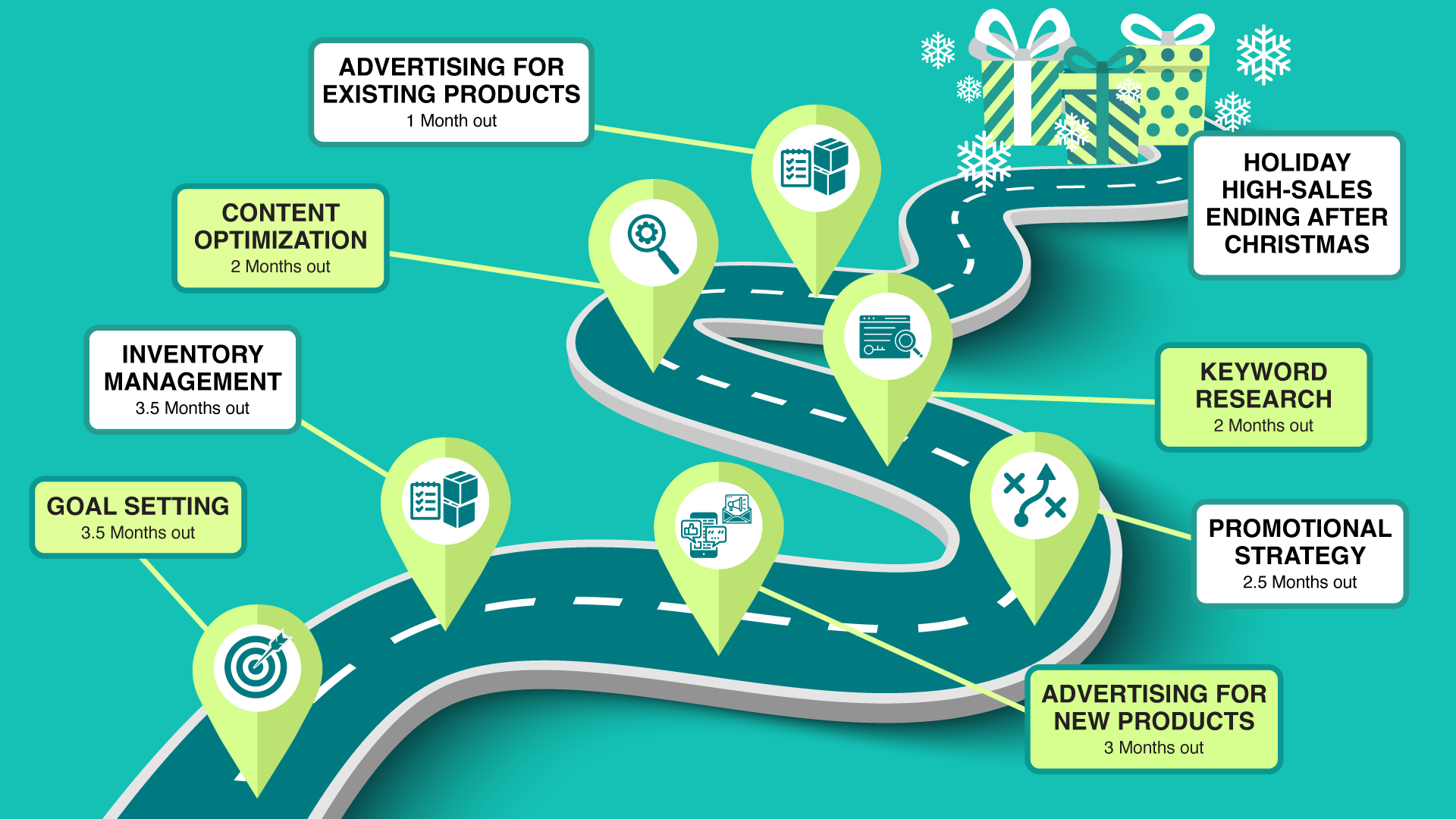5 Amazon Seller Tips for the Holidays

The holidays are fast approaching, with deals already spiking as Amazon kicked off the season with the Prime Early Access Sale. Many experts anticipate that Q4 2022 will be the most lucrative yet, and it’s just getting started.
That said, economic uncertainty has prompted shoppers to search for the best deals and product value ahead of Black Friday, making the preparation window for sellers much shorter than in previous years. What’s more, Salesforce anticipates that 51% of consumers will purchase fewer holiday gifts this time around.
To help you reach consumers when they are ready to buy and make the most of this season, we built a list of tips that will get every aspect of your ecommerce business up to speed. With excess inventory, inflationary pressures and other unprecedented events, it’s vital to give your Amazon seller strategy the final tweaks it needs to positively impact your sales in Q4. Here’s what you need to know.
Consider these key seller dates.
According to Amazon, these are some of the main dates and events to prepare for. Be sure to mark your calendar so that you don’t miss any opportunities.
- August 3rd - Holiday promotion submissions open in Vendor Central and Seller Central.
- September 17th - Deadline to submit 7-day deals, Best Deals, and Lightning Deals.
- October 21st to November 17th - Inbound shipping cutoff for vendors: Deal inventory must be in transit.
- October 24th to November 17th - FBA inventory cut-off date for sellers: Shipments should arrive well before the key shopping dates for the holiday season. Inventory should arrive at fulfillment centers by this date.

Set relevant goals.
Once you’ve marked the critical Amazon holiday deadlines on your calendar, start preparing the required elements and thinking about budget allocation across this prolonged season. Amazon advertising and promotion budgets should be specifically planned around these peak dates.
As you start campaign planning, it’s important to set realistic expectations and key performance indicators that you can regularly keep track of on your data dashboard. If you’re uncertain what those should be, consider building out KPIs for each one of the steps outlined here, and keep in mind that your numbers may differ from other seasons. Audiences are often subject to change during the holidays, which is why our experts recommend determining your audience pre-holiday season to better plan your campaigns and initiatives.
A good step is to leverage past sales data (including Prime Day) to inform your strategy and goal-setting for this year. This will also help when it comes to inventory planning.
Become retail ready.
As we always say, advertising drives the most highly-qualified traffic, and retail readiness drives conversion. But what does it mean to be retail-ready?
1. Inventory management
First, ensure you have an inventory plan in place. The sooner you can determine which products you plan on selling and guarantee you're not facing any inventory issues such as spoilage, deadstock, or low or high inventory levels, the sooner you can plan your other business elements. A fundamental part of managing inventory is reviewing your past sales to forecast this year's. Analyze your products' historical data, their performance during Prime Day, and which of your items (and your competitors’) could skyrocket during the holidays.
The next step is to ship your inventory to Amazon fulfillment centers before November 2 for Black Friday and December 1 for Christmas. With shipping and inventory in place, you can move on to advertising strategies, promotions, product detail pages and catalogs according to the products you have in stock.
2. Optimized content on Amazon
Product detail pages are vital for driving conversions and building trust with your customers, so spend time optimizing your pages' critical elements, then split-testing your work. We recommend starting with your product detail pages and A+ content. Ideally, this should begin as early as possible as A+ content takes the longest to build out. We encourage sellers to start preparing their creative in September.
If you’re not sure whether you need to update your A+ content, ask yourself: are we using comparison charts? Are we using all five modules? What about Brand Story? If the answer is no, it’s probably a good time to take another look at your content. What’s more, you can take the opportunity to refresh your current images and add holiday themes and festive overlays. Your images should sell the product on their own. Once creative is produced, add it to the platform to ensure Amazon approves it in advance.
Brand Stores should also be tailored for the holiday season. One strategy for your Brand Store is to create "store versions," where you can duplicate a page in your store, update the images, videos, or layout and schedule that version to run during a predesignated period. Store versions are helpful for quick updates that you wouldn't want to carry over into the new year or past a specific peak season. Another strategy is adding a Holiday Favorites page and running Sponsored Brand Ads. These should be done at least a month in advance.
Our tip for optimizing copy is to review your top ASINs ahead of time to determine the top sellers and ensure they have robust titles, bullets, and descriptions. Be careful when adding keywords like "gift" or "present" in your listings during the holiday season, as it goes against Amazon policies. Instead, be strategic in how you are updating your listing copy and backend terms, determine what highly qualified keywords competitors are using and aim to be informative to your target customer.
3. Keyword Research
The months leading into Q4 and the holiday season are great times to conduct keyword research, update your current list and search for holiday-centric keywords to evaluate every opportunity.
Develop a competitive promotional strategy.
We can’t depend on consumers searching across e-retails, we need to stand out among the competition with an attractive promotional strategy. Some of the Amazon promotions that can come in handy during this long holiday season are:
1. Amazon Coupons (run time of up to 90 days)
Flexible and low-cost, these are great for driving velocity and increasing sales.
2. Best Deal/7-Day Deals (run time of up to two weeks for Vendors and one week for Sellers)
These are brand awareness tools that are better suited for well-established brands on the platform. The discount minimums are high, and merchandising fees are required.
3. Lightning Deals (run time of up to 12 hours)
Similar to above, these are high-cost brand awareness tools. They also have rigid approval policies and, even if approved, they are not guaranteed to run. Longer run times allow for more traffic to be driven to detail pages.
4. Promo Codes (run time of up to 120 days)
Great for brands with a strong social media presence or marketing campaigns. These can attract customers to buy on the channel and capture new purchases. Promo codes are the best option for specific targeting and having more control over the audience you reach.
It’s important to keep in mind that deals have a submission deadline. This year, it fell on September 17th for Black Friday and Cyber Monday. Also, review run times to better plan out your season’s promotional strategy.
Consider these Amazon Advertising best practices.
Once you have everything in place to be retail-ready, Amazon Advertising is necessary to unlock growth over the holiday season. It will not only help with competitive visibility; it can also improve organic rank and drive incremental sales when done correctly.
Considering the budgets you have determined in your goal-setting phase, you should start building your advertising campaigns based on your objectives. If you are a new seller with a new product, we recommend you begin your advertising efforts as soon as possible. Three months is the minimum to gather data and gain relevance within the algorithm.
For sellers with existing products, give yourself at least a month in advance to begin new campaigns or refresh your current ones. Your products have triggered the flywheel or rank organically, so they will have an easier time staying relevant during the holiday season. Build awareness in advance through high-volume seasonal search terms—leading up to higher-converting campaigns to retarget and capture those early visitors when they are ready to buy.
Last but not least, examine your data and metrics regularly to ensure your holiday advertising strategy is as optimized as possible throughout the season.
Recap the peak season.
The work you or your agency have to do on Amazon doesn’t end after the holidays. It’s fundamental to look back at your wins and losses over the last couple of months to guide your 2023 planning and continue to drive visibility on the platform.
Some ways to recap the season include:
- Reviewing analytics to measure your successes (or failures) and your competitors’.
- Paying attention to customer feedback through reviews, cancellations and returns.
- Applying learnings to your New Year planning.
- Refreshing your keyword lists, ads and content to remove seasonal copies and imagery.
All in all, it’s never too late to set your business up for success. While the task may seem daunting, spending your time and effort on a brief list of products that move the needle is what will pay off. Follow these steps, make relevant optimizations and results will follow.
Learn more information about our Amazon Services.
Related
Thinking
-
![gamer opinion piece]()
Blog Post
Your Audience Is No Longer Just Gamers, Because We Are All Gamers By Pablo Castillo 4 min read -
![Four stacks of cash sitting atop a printout of different charts and graphs.]()
Blog Post
Decoding Web3: How Blockchain is Transforming Commerce and Brands By Xuanmai Vo 5 min read -
![A human hand extended to touch fingers with a robotic hand, evocative of Michaelangelo's "The Creation of Adam"]()
Blog Post
2024 Predictions: Upcoming Innovations and Behaviors to Plan for Now By Media.Monks 6 min read
Make our digital heart beat faster
Get our newsletter with inspiration on the latest trends, projects and much more.
Media.Monks needs the contact information you provide to us to contact you about our products and services. You may unsubscribe from these communications at any time. For information on how to unsubscribe, as well as our privacy practices and commitment to protecting your privacy, please review our Privacy Policy.



